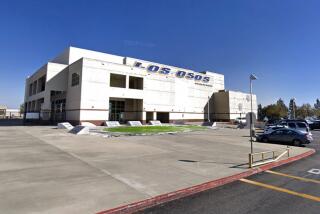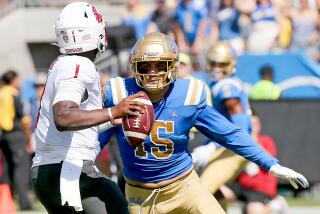PARALYZED FOOTBALL PLAYER DeWAYNE LYONS VOWS TO WALK AGAIN : He’s Down, but He Hasn’t Given Up
- Share via
A damp blanket of fog had settled on the football stadium, blurring the lights, as two high school teams prepared to play.
On one sideline sat DeWayne Lyons, his mind carrying him back a year, to the nights he played in the Chatsworth High secondary, breaking up passes, tackling ballcarriers, earning all-league honors despite his size, 5 feet 8 inches and 152 pounds.
As he sat in the gloom, Lyons focused on an area just beyond the 35-yard line.
And it all rushed back to him--the play, the catch, the collision, the fall.
Again, he felt the searing flash of pain, the tingling streaking down his body, then the numbness as he lay, face-down in a puddle, the mud oozing through his face mask.
He thought about a horrible show he had just seen on TV. It was the Marc Buoniconti story. It had been shown at halftime of a college game just 6 days earlier. Lyons had watched as the cameras caught the young linebacker from the Citadel being carried from the field and then, a year later, sitting in a wheelchair, paralyzed.
“I thought to myself, ‘No way. This can’t be happening to me,’ ” Lyons recalled. “I figured I’d just twisted something the wrong way and I’d get up out of the mud in a few minutes. It was just the second quarter, and I was wondering if I’d be able to play again in the second half.”
Lyons, a strong and talented football player, did not get up. And he did not play again.
Recently, Lyons returned to the same field.
He came back in a wheelchair.
The collision with a receiver on the night of Dec. 4, 1987, in a playoff game against Fairfax High, crushed the fifth vertebra in Lyons’ neck. He was left paralyzed from the waist down and with serious impairment to the function of his arms and hands.
He says he will walk again. Doctors have told him that he probably won’t.
When he arrived at Northridge Hospital Medical Center that night, doctors weren’t even sure Lyons would live through the night. His condition fluctuated between critical and serious. His breathing was labored as doctors sought to discover the extent of the injury.
There was some encouraging news. One doctor told Lyons and his mother that he thought the damage might be only temporary, that the blow to the head had caused swelling on the spinal cord and that when the swelling was reduced, the pressure on the fragile nerves that carry signals from the brain to the body might subside. And that Lyons might be OK in a week or two.
X-rays, however, revealed the truth. The vertebra had been irreversibly damaged. Bone fragments were floating in the fluid surrounding the hair-thin nerves of the spinal cord, threatening even more injury.
Two major operations followed, one to take a bone from Lyons’ hip and graft it to the shattered spine, the other to locate and remove the bone chips. “I knew it was serious. I couldn’t move,” Lyons said. “But for a while I kept thinking that it wasn’t permanent, it was just something that would go away in a few weeks. My friends came to visit me and we talked about when I’d be getting back on my feet. We even talked about whether I might get back on the football field for the last playoff game.
“Then, one day, they told me I probably would never walk again. (The doctor) told me that most of the patients he had seen with my injury, with something that bad, never walked again.”
Lyons’ mother, Sheila Thomas, was in the hospital room that day. She said she had also been led to believe that the devastating effects of the injury would subside over a few weeks or a month.
“I remember hearing those words, ‘probably not walk again,’ and I was just stunned,” she said. “That was the first time, really, that I had thought about that.
“When DeWayne heard that, he cried a little bit and I could see the hurt in his eyes so clearly. That’s what I remember. Looking at his eyes and seeing that terrible hurt.”
Lyons asked his mother to leave the room. He wanted to be alone. Then, moments later he called her back in. “He looked at me and said, ‘Momma, did the doctor say all of his patients with this injury would never walk again, or did he say most of them?’ ” she recalled. “I told him the doctor said most of them. And DeWayne looked at me and said, ‘Momma, I’m gonna be one of the ones who do walk again.’ ”
On Christmas Eve, he was transferred from the private Northridge hospital to Rancho Los Amigos in Downey, a county facility.
He stayed there until June 22, when he was driven back to Chatsworth, where he attended his high school graduation and received the diploma he had earned through tutoring sessions and testing in the hospital.
Today, Lyons, who now weighs about 135 pounds, spends most of his time in the Culver City apartment he shares with his mother, brother and sister. He sits in his lightweight wheelchair and struggles to get from room to room. A nursing attendant helps his mother.
Two days a week, his mother drives him to West Los Angeles College, where Lyons has begun studying accounting.
“I like math,” Lyons said. “I like working with numbers.”
But what he loved was football.
“I wasn’t just in it because it was the thing to do,” he said. “I was crazy about football. I lived for it. I loved it. I had big plans to play in college. And I never once thought about getting hurt playing football.
“And then I saw that show on Marc Buoniconti getting hurt, and I thought about it a lot that week. And that weekend, the same thing happened to me.”
His medical bills, which have mostly been covered by Medi-Cal and the California Children’s Fund, have approached $150,000. Chatsworth school officials staged a benefit charity basketball game for Lyons in February and raised about $7,000, Lyons’ mother said.
But recently, the family hired an attorney to look into the school’s possible liability for the accident, and school officials have cooled to the situation.
In the days immediately after the accident, the Chatsworth football coach, Myron Gibford, said: “It shakes you up pretty good. I don’t know if I’ve come to grips with it.”
Recently, when asked how the accident has affected him and his 1988 team, he said: “It was just a bad accident, and I don’t want to go back to it. I just don’t want to be any part of any story about it. It’s history. I don’t want my kids thinking about it. I don’t want to talk about this anymore.”
Donna Wyatt, the school’s athletic director, said: “I don’t know where DeWayne is. I have no way of knowing that because I have no records of him. He is not a student here anymore. I don’t know who might have any records of him. That’s not my job. I have no feelings about the situation one way or the other. We have no reason to keep track of him.”
Whether people know where he is or not, Lyons plans to keep on keeping on. “I won’t give up,” he said. “I have dreams about this all the time. Almost every night. And in all of the dreams, I never see myself in a wheelchair. I see myself walking and running.
“Maybe that means something.”
More to Read
Get our high school sports newsletter
Prep Rally is devoted to the SoCal high school sports experience, bringing you scores, stories and a behind-the-scenes look at what makes prep sports so popular.
You may occasionally receive promotional content from the Los Angeles Times.






